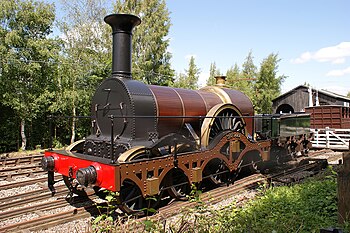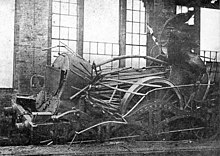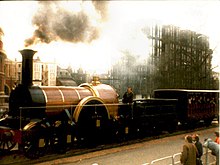| This article includes a list of general references, but it lacks sufficient corresponding inline citations. Please help to improve this article by introducing more precise citations. (December 2014) (Learn how and when to remove this message) |

The Great Western Railway Iron Duke Class 4-2-2 was a class of 7 ft 1⁄4 in (2,140 mm) broad gauge steam locomotives for express passenger train work.
History
The prototype locomotive, Great Western, was built as a 2-2-2 locomotive in April 1846, but was soon converted to a 4-2-2 arrangement, with the leading wheels set rigidly within the sandwich framing, rather than in a separate bogie. The remainder of the class entered service between April 1847 and July
The Iron Duke locomotives were fast for their time, and were recorded reaching 78.2 mph (125.9 km/h). They were used to haul the Flying Dutchman express train, which was the fastest express train in the world for several decades. In 1852, the daily service from London Paddington to Exeter (194 miles or 312 km) was achieved with an average speed of 53 mph (85 km/h), with the flatter section between London and Swindon covered at an average speed of 59 mph (95 km/h).
From about 1865, the Iron Duke Class was known as the Alma Class.
In May to July 1870, three locomotives (Great Britain, Prometheus and Estaffete) were extensively rebuilt with new frames and boilers, but retaining their original names. Following these, further locomotives were built to similar specifications, entering service between August 1871 and July 1888. These new locomotives are generally referred to as the Rover class. Although these locomotives took the names of withdrawn locomotives of the original design, they were not rebuilt from them like the first three, but entirely new locomotives (though it is believed that Rover, Swallow and Balaklava may have included some parts from the earlier locomotives of those names).
Apart from the three conversions, the original locomotives were withdrawn between December 1870 and June 1884. Lord of the Isles (the last to be withdrawn) was initially preserved by the GWR at Swindon Works, but was scrapped in January 1906 owing to the pressure of space. The three conversions were withdrawn between September 1880 and October 1887, while the other locomotives to the later design were all withdrawn with the end of the GWR 7 ft 1⁄4 in (2,140 mm) broad gauge in May 1892 (except Hirondelle, which had been withdrawn in December 1890).
Many of the nameplates can be seen at the National Railway Museum and at the Museum of the Great Western Railway, while the driving wheels from Lord of the Isles can also be seen at Swindon.
Locomotives
2-2-2 Great Western
| Great Western | |||||||||||||||||||||||||||
|---|---|---|---|---|---|---|---|---|---|---|---|---|---|---|---|---|---|---|---|---|---|---|---|---|---|---|---|
| |||||||||||||||||||||||||||
| |||||||||||||||||||||||||||
The prototype for this class was named the Great Western and built in 1846. Named after the railway, it was designed to show how the 2-2-2 express engines could be improved; its 8-foot-diameter (2.438 m) driving wheels were one foot (305 mm) larger than those of the successful Fire Fly class. It broke its leading axle after a short while in service and was subsequently rebuilt as a 4-2-2, becoming part of the Iron Duke class.
Iron Duke class
| Iron Duke Class | |||||||||||||||||||||||
|---|---|---|---|---|---|---|---|---|---|---|---|---|---|---|---|---|---|---|---|---|---|---|---|
 Hirondelle Hirondelle | |||||||||||||||||||||||
| |||||||||||||||||||||||
| |||||||||||||||||||||||


| Name | Built | Withdrawn | Details and information |
|---|---|---|---|
| Great Western | 1846 | 1870 | Rebuilt from the 2-2-2 first, prototype, locomotive, with an 18 ft 11+1⁄2 in (5.779 m) wheelbase. Name of the Great Western Railway company and Brunel's first steam ship, SS Great Western of 1838. |
| Great Britain | 1847 | 1880 | Second production locomotive, one of the first batch built, with an 18 ft 6 in (5.639 m) wheelbase. Name of the country, Great Britain, and Brunel's SS Great Britain steamship of 1843. |
| Iron Duke | 1847 | 1871 | One of the first batch built, with an 18 ft 6 in (5.639 m) wheelbase. Iron Duke was a reference to the Duke of Wellington. |
| Emperor | 1847 | 1873 | One of the first batch built, with an 18 ft 6 in (5.639 m) wheelbase. An emperor is a ruler of an empire. |
| Lightning | 1847 | 1878 | One of the first batch built, with an 18 ft 6 in (5.639 m) wheelbase. Lightning is a fast and powerful discharge of electrostatic energy from clouds. |
| Pasha | 1847 | 1876 | One of the first batch built, with an 18 ft 6 in (5.639 m) wheelbase. A pasha is a Turkish chieftain. |
| Sultan | 1847 | 1874 | One of the first batch built, with an 18 ft 6 in (5.639 m) wheelbase. Involved in an accident at Ealling: it ran into some goods wagons that were being shunted, and six passengers were killed. A sultan is a Muslim ruler. |
| Courier | 1848 | 1877 | A courier is a person who carries packages. |
| Dragon | 1848 | 1872 | A dragon is a mythological type of beast. |
| Hirondelle | 1848 | 1873 | 'Hirondelle' is French for a swallow. |
| Rougemont | 1848 | 1879 | Rougemont Castle is a site of historic interest in Exeter, within the GWR region. |
| Tartar | 1848 | 1876 | A Tartar is an eastern European Turkic speakers. |
| Warlock | 1848 | 1874 | A Warlock is a male witch. |
| Wizard | 1848 | 1875 | A wizard is a traditional magician or magus. |
| Swallow | 1849 | 1871 | A swallow is a fast-flying bird. |
| Timour | 1849 | 1871 | Timour, also known as Timur or Tamerlane, was a 14th-century central Asian ruler. |
| Tornado | 1849 | 1881 | A tornado is a powerful wind. |
| Estafette | 1850 | 1884 | Rebuilt 1870 with a new boiler and its wheelbase increased to 19 ft. 'Estafette' is French for a military courier. |
| Perseus | 1850 | 1880 | Perseus was a character in Greek mythology. Its boiler exploded at the locomotive sheds at Westbourne Park outside Paddington station, 8 November 1862. |
| Prometheus | 1850 | 1887 | Rebuilt in 1870 with a new boiler and its wheelbase increased to 19 ft, it was similar to the Rover class introduced the following year. Prometheus was a character in Greek mythology. |
| Rover | 1850 | 1871 | A rover is a wanderer. |
| Amazon | 1851 | 1877 | The Amazons were a mythical tribe of warrior women. |
| Lord of the Isles | 1851 | 1884 | Before entering service, named Charles Russell in honour of a GWR director; exhibited at the Great Exhibition in London. The following year it hauled the director's inspection train from Paddington station to Birmingham Snow Hill and was involved in a collision at Aynho railway station when it ran into the back of a stopping train and was derailed, several people were seriously injured. It was being driven at the time by Mr Brunel and Mr Gooch.
After withdrawal in 1884, the locomotive was stored at Swindon Works until 1906; during this time it was exhibited at Edinburgh in 1890, Chicago in 1893, and Earl's Court, (London) in 1897. When exhibited, it was claimed that between 1851 and July 1881 it was in continual service and completed 789,300 miles on its original boiler. Lord of the Isles was a hereditary title of the Scottish nobility, given to the eldest son of the British monarch. |
| Alma | 1854 | 1872 | Commemorates the Crimean War Battle of Alma (1854). |
| Balaklava | 1854 | 1871 | Commemorates the Crimean War Battle of Balaclava (1854). |
| Crimea | 1855 | 1876 | Commemorates the Crimean War (1853 to 1856). |
| Eupatoria | 1855 | 1876 | Commemorates the Crimean War Battle of Eupatoria (1855). |
| Inkermann | 1855 | 1877 | Commemorates the Crimean War Battle of Inkerman (1854). |
| Kertch | 1855 | 1872 | Commemorates the capture of Kertch during the Crimean War (1855). |
| Sebastopol | 1855 | 1880 | Commemorates the Siege of Sebastopol during the Crimean War (1854–1855). |
Rover class
| Rover Class (or Iron Duke Class rebuilt) | |||||||||||||||||||||
|---|---|---|---|---|---|---|---|---|---|---|---|---|---|---|---|---|---|---|---|---|---|
 Dragon at Taunton while working the last broad gauge train from London to Penzance on 20 May 1892 Dragon at Taunton while working the last broad gauge train from London to Penzance on 20 May 1892 | |||||||||||||||||||||
| |||||||||||||||||||||
| |||||||||||||||||||||

| Name | Built | Withdrawn | Details and information |
|---|---|---|---|
| Balaklava | 1871 | 1892 | Name reused from Iron Duke class locomotive withdrawn in 1875 (see above for details). |
| Hirondelle | 1871 | 1890 | Name reused from Iron Duke class locomotive withdrawn in 1873 (see above for details). |
| Iron Duke | 1873 | 1892 | Name reused from Iron Duke class locomotive withdrawn in 1871 (see above for details). |
| Timour | 1873 | 1892 | Name reused from Iron Duke class locomotive withdrawn in 1871 (see above for details). |
| Sultan | 1876 | 1892 | Name reused from Iron Duke class locomotive withdrawn in 1874 (see above for details). |
| Tartar | 1876 | 1892 | Name reused from Iron Duke class locomotive withdrawn in 1876 (see above for details). |
| Warlock | 1876 | 1892 | Name reused from Iron Duke class locomotive withdrawn in 1874 (see above for details). |
| Amazon | 1878 | 1892 | Name reused from Iron Duke class locomotive withdrawn in 1877 (see above for details). |
| Courier | 1878 | 1892 | Name reused from Iron Duke class locomotive withdrawn in 1877 (see above for details). |
| Crimea | 1878 | 1892 | Name reused from Iron Duke class locomotive withdrawn in 1876 (see above for details). |
| Eupatoria | 1878 | 1892 | Name reused from Iron Duke class locomotive withdrawn in 1876 (see above for details). |
| Inkermann | 1878 | 1892 | Name reused from Iron Duke class locomotive withdrawn in 1877 (see above for details). |
| Lightning | 1878 | 1892 | Name reused from Iron Duke class locomotive withdrawn in 1878 (see above for details). |
| Alma | 1880 | 1892 | Name reused from Iron Duke class locomotive withdrawn in 1872 (see above for details). |
| Bulkeley | 1880 | 1892 | This locomotive worked the last broad gauge passenger train out of London Paddington station on the afternoon of 20 May 1892. It worked this as far as Bristol Temple Meads and then returned early the following morning with the last train from Penzance, thus being the last broad gauge locomotive to work a passenger train on the main line. The name, Bulkeley, honoured a long-standing Great Western Railway director. It had previously been carried on a Sir Watkin class 0-6-0T that had been sold to the South Devon Railway Company in 1872. |
| Dragon | 1880 | 1892 | Name reused from Iron Duke class locomotive withdrawn in 1872 (see above for details). |
| Emperor | 1880 | 1892 | Name reused from Iron Duke class locomotive withdrawn in 1873 (see above for details). |
| Great Britain | 1880 | 1892 | Name reused from Iron Duke class locomotive withdrawn in 1880 (see above for details). |
| Sebastopol | 1880 | 1892 | Name reused from Iron Duke class locomotive withdrawn in 1880 (see above for details). |
| Great Western | 1888 | 1892 | Great Western had the honour of hauling the last broad gauge "Cornishman" service from London Paddington, which was the last through train to Penzance, although the locomotives were changed at Bristol Temple Meads. The name was reused from an Iron Duke class locomotive withdrawn in 1870 (see above for details). |
| Prometheus | 1888 | 1892 | Name reused from Iron Duke class locomotive withdrawn in 1887 (see above for details). |
| Tornado | 1888 | 1892 | Name reused from Iron Duke class locomotive withdrawn in 1881 (see above for details). |
Replica

A working replica of Iron Duke was constructed in 1985 using parts from two Hunslet Austerity tanks for the 'Great Western 150' celebrations. It is part of the National Railway Collection but is currently on long-term loan to the Didcot Railway Centre, which has a section of working broad gauge track. The boiler certificate has expired so it cannot currently be steamed.
The replica appeared in The Railway Series book Thomas and the Great Railway Show, in which it was portrayed with whiskery eyebrows and a walrus moustache.
References
- Casserley, H.C. (1960). Historic locomotive pocket book. London: Batsford. pp. 12–13.
- Reed (1953), pp. B18–B20.
- "History of the Broad Gauge". The Broad Gauge Society. Retrieved 30 January 2007.
- Reed (1953), pp. B29≠B31.
- Reed (1953), p. B18.
- Tyler, H.W. (25 November 1862). Accident Returns: Extract for the Accident at Westbourne Park on 8th November 1862 (PDF) (Report). Board of Trade. Retrieved 9 February 2024 – via The Railways Archive.
- Accident at the Opening of the London and Birmingham Railway, Bell's Weekly Messenger, 4 October 1852, p5
- The Chicago Exhibition, The Royal Cornwall Gazette, 28 April 1892, p6
- "Steam locomotive entitled Iron Duke". Our collection. National Railway Museum. Archived from the original on 20 December 2013. Retrieved 13 December 2013.
- Reed, P. J. T. (February 1953). White, D. E. (ed.). The Locomotives of the Great Western Railway, Part 2: Broad Gauge. Kenilworth: RCTS. ISBN 0-901115-32-0.
External links
- "What was the Broad Gauge?". The Broad Gauge Society.
| Great Western Railway locomotives | |||||||||||||||
|---|---|---|---|---|---|---|---|---|---|---|---|---|---|---|---|
| Swindon broad gauge |
| ||||||||||||||
| Wolverhampton standard gauge |
| ||||||||||||||
| Swindon standard gauge |
| ||||||||||||||
| Absorbed locomotives |
| ||||||||||||||
| Narrow gauge locomotives |
| ||||||||||||||
| By wheel arrangement | |||||||||||||||
| General | |||||||||||||||